Ciao Italianista contains affiliate links and is a member of the Amazon Services LLS Associates Program. If you make a purchase using one of these Amazon links, I may receive compensation at no extra charge to you. See my disclosure policy for more information.
Best Tuscan Ragù For Any Day Of The Week
Rich, robust, and flavorful, this Tuscan ragù is a magnificent mixture of meat, tomato sauce, and wine slowly cooked in a soffritto of onion, celery, and carrots served over tagliatelle. A winning pasta course that is rewarding and easy to make.
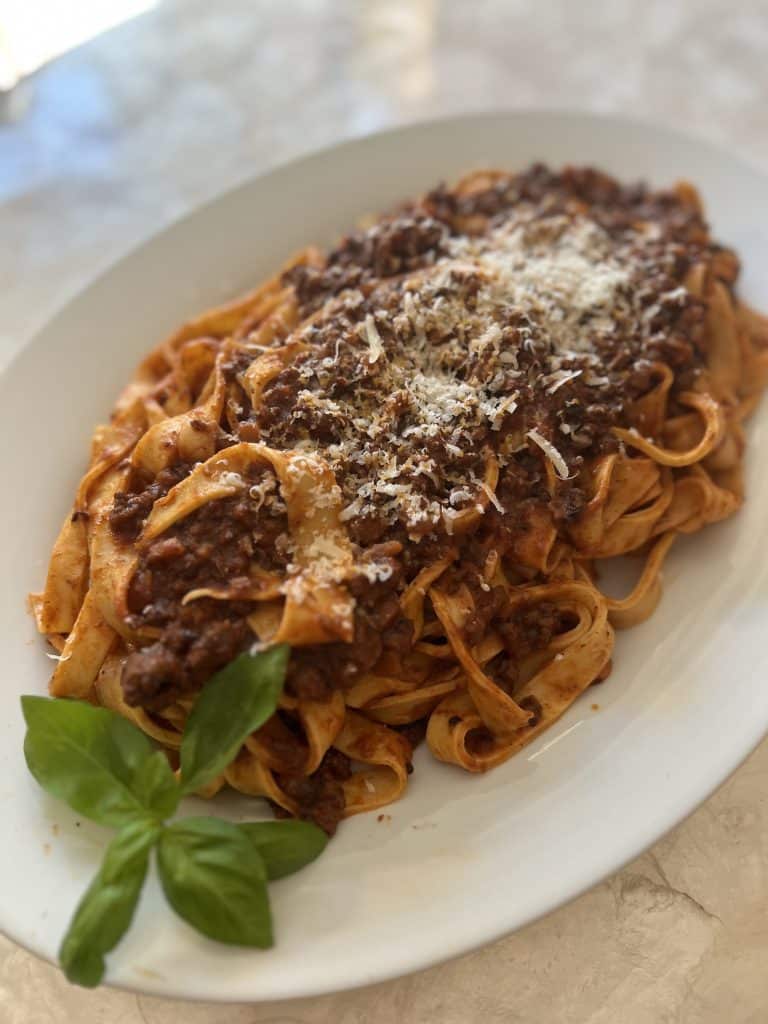
If you are looking for the best Tuscan ragù meat sauce, then this authentic recipe with fresh ingredients inspired by the Cooking Class and Lunch at a Tuscan Farmhouse with Local Market Tour from Florence is for you!
I went on this tour over two years ago and have been making this Tuscan ragù recipe at home ever since. I have experienced making it with different meats, but this classic recipe is easy and as authentic as it gets.
Whether you want to fill your house with delicious aromas from slow food cooking before a meal with family or friends, or you are looking for a meat sauce that you can make today and freeze for later, look no further than this Tuscan ragù recipe.
So grab your appetite and let’s make authentic Tuscan ragù.
Best Tuscan Ragù For Any Day Of The Week
What is Ragù?
Ragù is a meat-based sauce with tomato that is found in every region of Italy. Ragù is a general term for meat sauce with every region, province, and commune having its own spin on it adding local flavors.
Tuscan ragù is the meat sauce made in Tuscany, the region of Florence.
This meat sauce is usually paired with broad, flat pastas like tagliatelle or tube pasta like rigatoni and penne to catch the meat. It is also used as a meat filling in dishes like lasagna and ravioli.
Ragù was traditionally made on Sundays in Italian homes starting early in the morning and cooked slowly to develop a thick flavorful sauce. Since meat was too expensive for most people, it was only made on feast days and Sundays.
But why wait until Sunday? Make this Tuscan ragù any day of the week when you have at least 3 hours to let the flavors slowly infuse and the liquids burn off.
Why You’ll Love This Recipe
- Set it and forget it: Once you have added all the ingredients, you will leave it on low heat for several hours while you do other things, just coming back to stir it from time to time.
- Eat for a week: Although this ragù is immediately delicious, it tastes even better the next day and there will be plenty of leftovers.
- Freeze and reheat: Not ready to eat it now? No problem, just freeze for later and you’ll have a ready meal.
The Ingredients For Tuscan Ragù
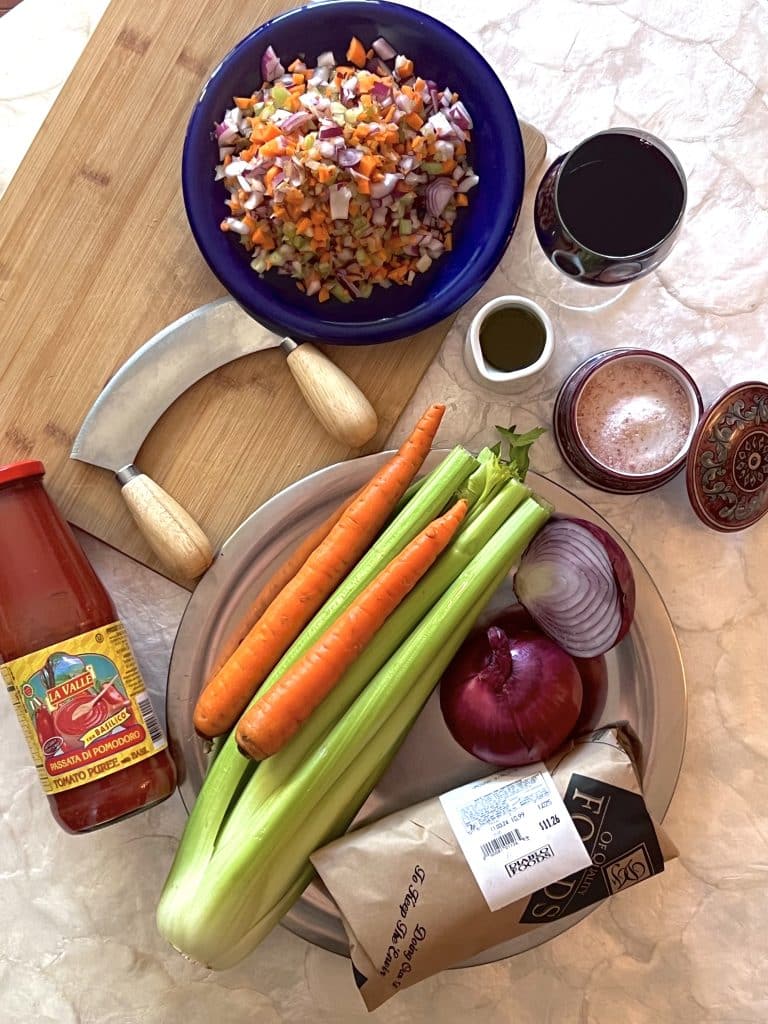
The ingredients for authentic Tuscan Ragù are:
- Celery
- Red Onion
- Carrot
- Extra Virgin Olive Oil
- Ground Beef
- Table Wine
- Tomato Passata
- Sea Salt
Make sure to check the recipe card below for a full list of ingredients and quantities.
Tomato passata, or puree, can be found in many grocery stores. However, you might have to go to a more high-end store that carries specialty items. There are also several different brands of tomato passata on Amazon.
Substitutions And Additions
To truly master the authentic Tuscan Ragù, you should strictly follow the recipe in the recipe card for ingredients, measurements and timings. However, it can be fun and tasty to change things up.
- Ground Beef → Ground Sirloin – ground sirloin is a leaner, higher quality meat than ground beef. It cooks more uniformly and has a heartier flavor than ground beef. But less fat means it’s harder to get that delicious browned meat flavor.
- Ground Beef → Ground Pork – either only using ground pork or adding ground pork to the beef gives your ragù a slightly sweeter and richer flavor especially if it contains fennel.
- Celery → More Onions – if you want to make the recipe only to discover you are out of celery, just add more onions.
- Mushrooms – for mushrooms lovers, add mushrooms to the soffritto!
Step By Step Instructions With Photos
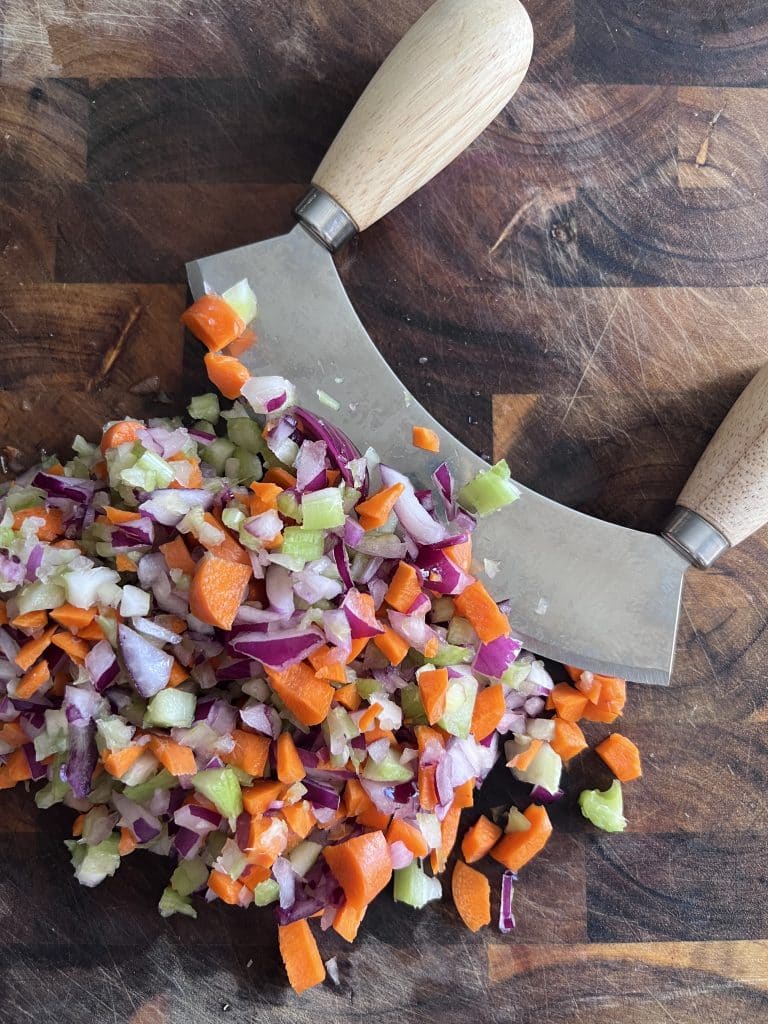
Step 1. Finely chop the celery, onion, and carrot (individually if using a food processor).
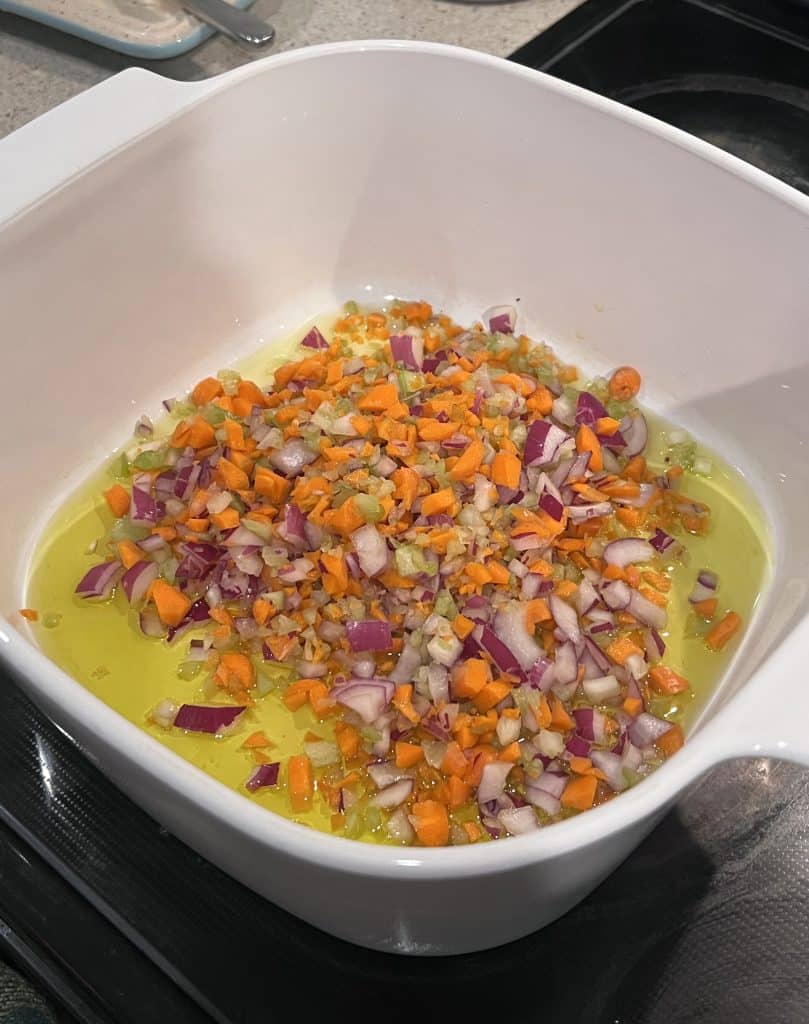
Step 2. Put the chopped mixture in a heavy-bottomed saucepan with the olive oil and heat over medium-high heat to make the soffritto. Sweat the vegetables until the red onion becomes translucent.

Step 3. Add the ground beef*, breaking it up with the spoon. The juice will release from the meat.
*this time I used ground sirloin

Step 4. Keep cooking until all the juices of the meat have evaporated scraping the bottom of the pan with your spoon continually to achieve more browning and flavor.

Step 5. At this stage add the wine, making sure to scrape off anything that is stuck to the bottom of the pan…that’s all flavor! Continue to simmer until the wine has reduced and the alcohol has burned off.
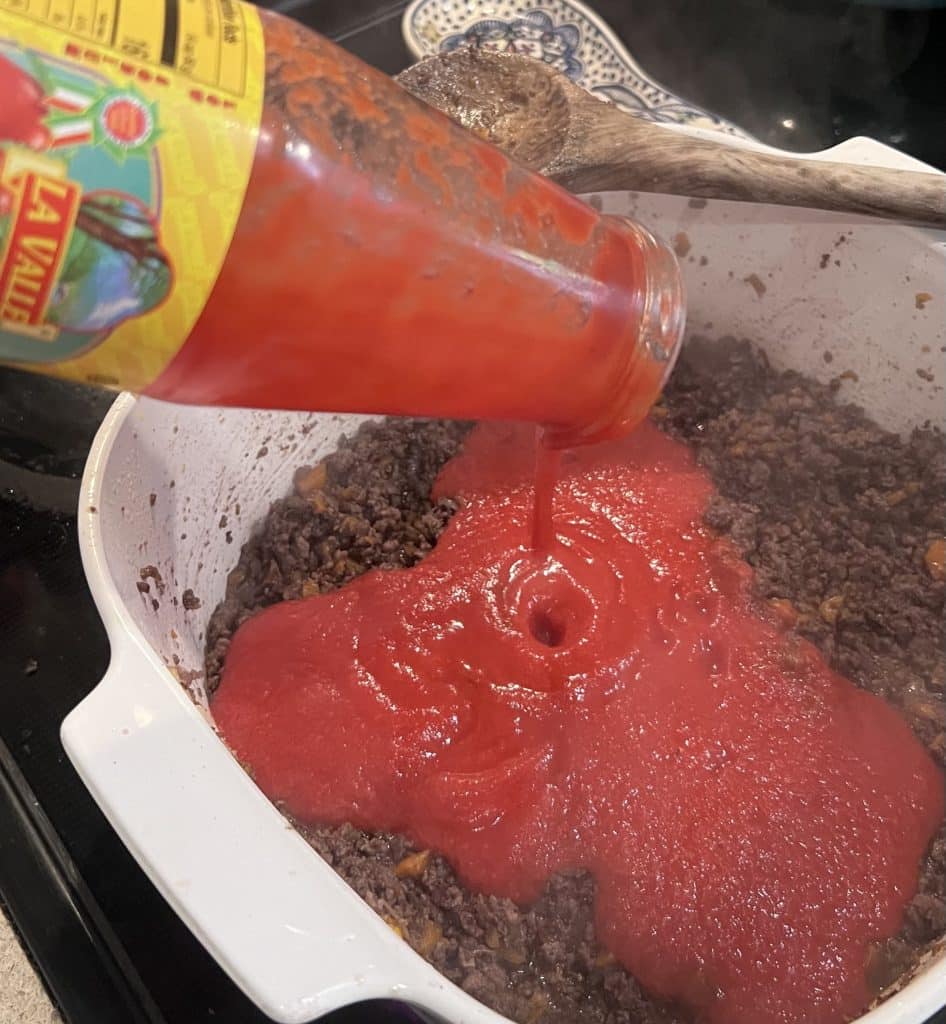
Step 6. Finally add the tomato passata and salt. Place the lid slightly ajar on the pan to allow the moisture to evaporate and the sauce to slowly thicken. Simmer on low heat for 2-3 hours.
After an hour and a half, check the consistency. If too dense, add a drop of water. NO MORE VINO.
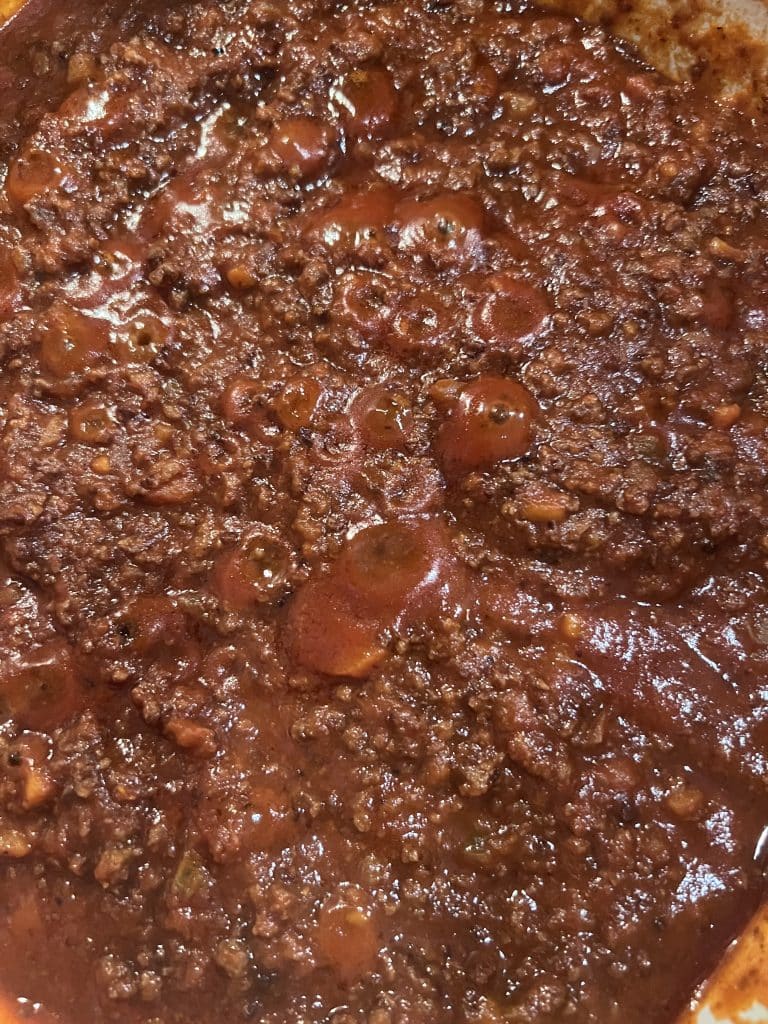
Step 7. When the sauce is thick and clings nicely to a spoon when it is held upright, your sauce is ready to use on your pasta. Cook the pasta and add some pasta water to the sauce.

Step 8. Serve over tagliatelle or another pasta type that will absorb and catch the sauce. Top with Parmigiano Reggiano. Pair with Chianti Classico. Enjoy!
How To Serve Tuscan Ragù
Tuscan ragù is often served with tagliatelle. Tagliatelle are long strips of pasta, about 1 cm wide, made with flour and eggs.
Since they are made of eggs, they are porous and perfect for soaking up the meat sauce. See the recipes for instructions on how to make tagliatelle at home.
Pair the tagliatelle al Tuscan ragù with Chianti Classico. The acidity in the wine made from Sangiovese grapes enhances the flavors in the meat sauce without overpowering the dish.
Serve tagliatelle al Tuscan ragù as the main course at a dinner party following the Tuscan bruschetta appetizer. Here’s the recipe for Tuscan bruschetta.
Storing And Reheating Suggestions
- Let the ragù cool completely before putting it in an airtight container.
- You can keep it in the fridge for 3 days.
- You can freeze it up to 6 months.
- To reheat, thaw in the fridge overnight, then heat on the stove over medium until it begins to bubble, stir and lower the heat, continue heating on low until ready to use on the pasta. Add pasta water to the sauce.
FAQs
What is the most well known Italian ragù ?
The most well known Italian ragù is Bolognese. Ragù Bolognese is meat sauce from Bologna. Unlike Tuscan ragù , Bolognese sauce uses milk or cream.
Do Italians put sugar in ragù?
Italians do not put sugar in their ragù because they use high quality, organic, ripe tomatoes that have enough natural sugar to cut through the acidity of the tomatoes.
What is soffritto?
Soffritto is a foundation of many Italian sauces, soups, and stews made by sauteing diced celery, onion, and carrots in olive oil over low heat for 30 minutes or until beginning to carmelize.
Buon Appetito! Let’s Eat!
Whether you make Tuscan ragù on a Sunday morning or you find another block of time during the week to make this ragù, you will fill your house with happiness and the aromas of the Italian countryside.
Slow cooking will always result in supreme flavors and a connection to joyfulness. Eat alone soaking up every last drop or share with friends and family.
Start with the soffritto and see where your imagination takes you. What type of meat will you use? Will you make substitutions and make something new? Or will you stick to the authentic Tuscan Ragù with tagliatelle?
To learn more about where I learned this recipe and to see the photos, read Epic Cooking Class At A Tuscan Farmhouse With Lunch and Local Market Tour.
To check availability and read reviews of this tour, click here.
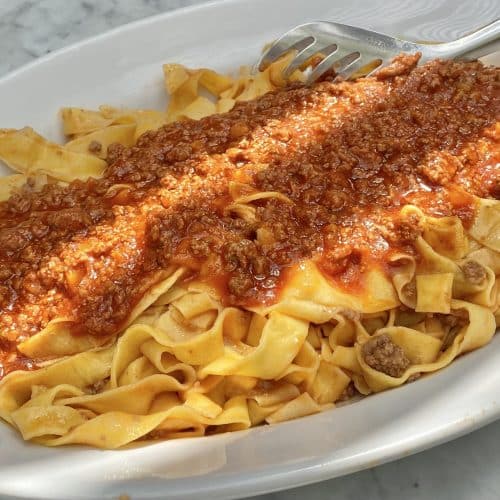
Tuscan Ragù
Ingredients
- 1 stalk celery
- 1 large onion
- 1 carrot peeled
- 6 tbsp olive oil extra virgin
- 14 oz. ground beef lean
- 1 glass table red wine
- 18 oz, tomato passata
- salt to taste
Instructions
- Finely chop the celery, onion, and carrot together (individually if using a food processor)
- Put the chopped mixture in a heavy-bottomed saucepan with the olive oil and heat over medium-high heat. Sweat the vegetables until the red onion becomes translucent.
- Add the ground beef, brown it and make sure that the meat is broken up. The juice will release from the meat. Keep cooking until all the juices have evaporated, scraping the bottom of the pan with your spoon continually to achieve more browning and flavor.
- At this stage, add the wine, making sure to scrape off anything that is stuck to the bottom of the pan. Continue to simmer until the wine has reduced and the alcohol has burned off.
- Finally add the tomato passata and salt to taste. Place the lid slightly ajar on the pan to allow the moisture to evaporate and the sauce to slowly thicken.
- Simmer on low heat for a minimum of 2 hours and a maximum of 3 hours. Stir occasionally to make sure it is not sticking to the bottom of the pan.
- After an hour and a half, check the consistency. If the sauce seems to loose, remove the lid to allow it to reduce faster and thicken up. If the sauce is too dense, add a drop of water, but no more wine.
- When the sauce is thick and clings nicely to a spoon when it is held upright, your sauce is ready to use on your pasta.
- Cook the pasta. Add some pasta water to the sauce. Drain the pasta. Top the past with the sauce and Parmigiano Reggiano. Serve and enjoy.

